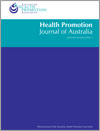
Health Promotion Journal of Australia
Volume 25 Number 3 2014
RESEARCH FRONT: Healthy Places and Spaces
HE14103Healthy places and spaces: the impact of the built environment and active transport on physical activity and population health
HEv25n3_EDHealth promotion success in Australia and a note of warning
HE14050Developing a research and practice tool to measure walkability: a demonstration project
Growing evidence shows that higher-density, mixed-use, pedestrian-friendly neighbourhoods encourage active transport, including transport-related walking. However, there is little objective data to benchmark the walkability of neighbourhoods within and between Australian cities in order to monitor planning and design intervention progress, and assess built environment and urban policy interventions required to achieve increased walkability. This demonstration project developed, trialled and validated a ‘Walkability Index Tool’ that could be used by policy makers and practitioners to assess the walkability of local areas; or by researchers to access geospatial data assessing walkability.
HE14050 Abstract | HE14050 Full Text | HE14050PDF (880 KB) Open Access Article
HE14004Active travel to work in NSW: trends over time and the effect of social advantage
Socioeconomic advantage, housing location and car ownership influence active travel for transport. Between 2001 and 2011, active commuting rose in inner Sydney, decreased slightly in outer Sydney and declined in the Greater Metropolitan Region. People living in high socioeconomic areas, more rural areas and areas with lower car ownership are more likely to actively commute. More needs to be done in New South Wales consistently across regions and socio-demographic groups to increase levels of active commuting.
HE14004 Abstract | HE14004 Full Text | HE14004PDF (285 KB) Open Access Article
HE14057Incidental physical activity in Melbourne, Australia: health and economic impacts of mode of transport and suburban location
Increasing physical activity has major health benefits, even in the overweight and the elderly, and active travel improves health and productivity. Conservative modelling for increased public transport use, walking and cycling showed annual savings of up to 272 deaths, 903 new cases of disease and overall up to $12.2 million in health costs and $22.9 million in production. Increasing active transport can considerably improve health and economic outcomes.
HE14053Associations between the frequency of cycling and domains of quality of life
HE14036Neighbourhood influences on mental health in master planned estates: a qualitative study of resident perspectives
The proliferation of new housing developments on Australia’s urban fringe presents unique opportunities to explore neighbourhoods and mental health. This study investigated the physical and social correlates of mental health in residents of new housing developments and found that mental health was influenced by service availability, security and a sense of community. These findings may help urban planners to design residential areas that promote healthy living.
HE14045Artificial light at night: a neglected population health concern of the built environment
HE14042Healthy places, active transport and path dependence: a review of the literature
This review examines the concept of path dependence to better understand barriers to change in the built environment. It explores whether policy-makers tend to become ‘locked-in’ to a particular development pattern that supports car-based transport over more active modes. Results suggest that this framework can assist in understanding barriers to change and provide insights into developing future successful public health interventions.
HE14039Building partnerships for healthy environments: research, leadership and education
Preventing contemporary chronic disease is a complex problem that can only be addressed by collaborative partnerships. The Healthy Built Environments Program is an exemplar of such a partnership. It brings health and the built environment together to create environments that support and encourage people to lead healthy lives on a daily basis.
HE14051We need more active travel intervention research – why not travel plans?
HE14038People’s experiences of using outdoor gym equipment in parks
HE14037Design and promotion of an outdoor gym for older adults: a collaborative project
HE14034Pole walking down-under: profile of pole walking leaders, walkers and programs in Australia and factors relating to participation
Surveys were administered to pole walking leaders and pole walkers to investigate the characteristics of pole walking leaders, walkers and programs in Australia. Participants’ perceptions of pole walking, and reasons for participation were identified. Pole walking is being practised by an older population for health and fitness benefits, and social, environmental, and personal enjoyment.
HE14041Gender differences in effectiveness of the Complete Health Improvement Program (CHIP) lifestyle intervention: an Australasian study
Lifestyle intervention programs are efficacious in treating chronic disease, but men appear to do better than women. This paper explores the short-term effectiveness of the Australasian Complete Health Intervention Program (CHIP) intervention. Defining the gender-specific physiological and behavioural factors that contribute to responsiveness to lifestyle change will assist in the development of more effective lifestyle interventions for both men and women.
HE14041 Abstract | HE14041 Full Text | HE14041PDF (111 KB) Open Access Article

